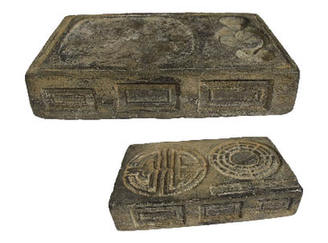|
Brick and Tile Inkstones
As one of the "Four Treasures of the Study," inkstones have been valued collectibles since ancient times, not only among ordinary people, but also imperial families. The Qing court had a particularly large collection of inkstones that included items from previous dynasties and contemporary masterworks. They were displayed in the Eastern Warm Chamber of the Palace of Heavenly Purity (Qianqinggong).
In 1768, the 43rd year of Emperor Qianlong's reign, the monarch ordered court officials to catalogue the imperial inkstone collection. The result was 24 volumes recording 241 inkstones dating from the Han to Qing dynasties. The first six volumes are devoted to 55 pottery items, the most precious being those made of Weiyang Palace tiles and Tongque Terrace tiles.
Ancient Chinese used various materials to make inkstones, though stone and pottery were common. As early as the Tang Dynasty (618-907), Qin-Han bricks and tiles were used in high-quality inkstones, as evidenced in these lines from Tang Dynasty poet Wu Rong in his Ode to Ancient Tile Inkstones: "Nothing is useless for anything, and broken tiles can become inkstones."
During the Tang and Song (960-1279) dynasties, people rubbed ancient bricks and tiles to make inkstones. The practice was once again in vogue during the Qing Dynasty (1644-1911), when debris from ancient palaces of the Qin, Han and Wei-Jin periods became a valuable source material. Bricks and tiles produced for the Han Dynasty's Tongque Terrace were made of finely processed clay mixed with walnut oil and elements such as cinnabar, lead and tin. Inkstones made from them have a fine texture that is as solid and lustrous as marble, and inksticks grind well on them. Those made from ancient tile ends engraved with characters were considered very precious.
 |
| A brick inkslab (top and bottom view). |
Such inkstones are good practical items and pleasant on the eyes. Many ancient scholars considered owning one a great honor. Celebrated Northern Song calligrapher Huang Tingjian (1045-1105) once inscribed an epitaph for Wang Wenshu, whose son sent him a Tongque tile in gratitude. Huang made the invaluable gift into an inkstone and wrote an inscription for it. Emperor Qianlong also expressed his appreciation of ancient brick and tile inkstones, and many in the Qing imperial collection bear his inscriptions.
Underground Brick Carvings
Beginning in the Warring States Period (475-221 B.C.) people started to produce engraved bricks, and the craft reached its zenith during the Qin and Han dynasties. Patterns were not carved directly – they were mostly manufactured by applying molds on adobes before firing. These engraved bricks are considered a prototype of true brick carving.
Based on archaeological discoveries, historians agree that brick carving in the true sense started in the Northern Song Dynasty (960-1127). Representative artifacts include a suite of brick carvings now in the collection of the National Museum of China, unearthed from a Song tomb found in Henan's Yanshi. In one carving, a young woman pokes charcoal in a fire as tea is brewed over it. In another, a woman prepares fish on a table, with a basin of clear water lying by her side on the floor and a steaming pot on the stove across the table. More women are featured in a third carving, washing and cooking. These masterfully executed carvings vividly reflect culinary customs of the Song Dynasty.
| 